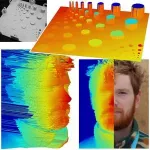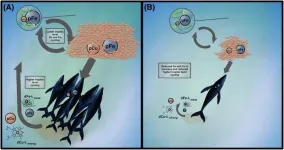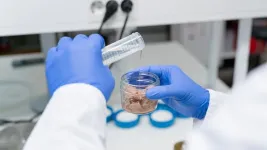(Press-News.org) WASHINGTON — Researchers have designed a single-photon time-of-flight LiDAR system that can acquire a high-resolution 3D image of an object or scene up to 1 kilometer away. The new system could help enhance security, monitoring, and remote sensing by enabling detailed imaging even in challenging environmental conditions or when objects are obscured by foliage or camouflage netting.
“Our system uses a single-photon detector approximately twice as efficient as detectors deployed in similar LiDAR systems reported by other research groups and has a system timing resolution at least 10 times better,” said research team member Aongus McCarthy, from Heriot-Watt University in the UK. “These improvements allow the imaging system to collect more scattered photons from the target and achieve a much higher spatial resolution.”
In Optica, Optica Publishing Group’s journal for high-impact research, a multi-institutional group of researchers from the UK and USA shows that the new system can construct a 3D image depicting a clearly recognizable human face from a person 325 meters away. The researchers were from Gerald Buller’s group at Heriot-Watt University, Robert Hadfield’s group at the University of Glasgow, Matthew Shaw’s group at the NASA Jet Propulsion Laboratory, and Karl Berggren’s group at MIT.
“This type of measurement system could lead to improved security and monitoring systems that could, for example, acquire detailed depth images through smoke or fog and of cluttered scenes,” said McCarthy, first author of the new paper. “It could also enable the remote identification of objects in various environments and monitoring of movement of buildings or rock faces to assess subsidence or other potential hazards.”
Light-based range finding
The single-photon time-of-flight depth imaging system uses the time it takes for a laser pulse to travel from the system to a point on an object and back to calculate the distance to the object. These time-of-flight measurements are then repeated for points across the object to obtain 3D information.
The new system uses an ultrasensitive detector called a superconducting nanowire single-photon detector (SNSPD) developed by the MIT and JPL research groups. The SNSPD can detect a single photon of light, which means that lasers with very low powers, including eye-safe lasers, can be used to perform measurements in a very short time and over long distances. To reduce noise levels, the detector was cooled to just below 1 Kelvin in a compact cryocooler system designed and built by the University of Glasgow group.
The researchers combined the cooled SNSPD with a new custom single-pixel scanning transceiver operating at a 1550-nm wavelength that was designed by McCarthy at Heriot-Watt University. They also added advanced timing equipment to measure extremely precise time intervals — accurate down to trillionths of a second (picoseconds). To put that into perspective, in just 1,000 picoseconds, light can travel about 300 millimeters (about 1 foot). This precision made it possible to distinguish surfaces separated by about 1 mm in depth from 325 meters away.
“These factors all provide improved flexibility in the trade-off between standoff distance, laser power levels, data acquisition time and depth resolution,” said McCarthy. “Also, since SNSPD detectors can operate at wavelengths longer than 1550 nm, this design opens the door to developing a mid-infrared single-photon LiDAR system, which could further enhance imaging through fog and smoke and other obscurants.”
3D measurements of distant objects
The researchers performed field tests of their LiDAR system on the Heriot-Watt University campus by taking measurements from objects that were 45 meters, 325 meters or 1 kilometer away.
To evaluate the spatial and depth resolution, they scanned a custom 3D-printed target with varying pillar sizes and heights. The system resolved features as small as 1 mm in daylight at 45 and 325 meters — a depth resolution approximately 10 times better than they had achieved previously. They also captured a 3D image of a human face at these distances using a 1 ms per-pixel acquisition time, an eye-safe 3.5 mW laser, and minimal data processing.
“The excellent depth resolution of the system means that it would be particularly well suited for imaging objects behind clutter, such as foliage or camouflage netting, a scenario that would be difficult for a digital camera,” said McCarthy. “For example, it could distinguish an object located a few centimeters behind a camouflage netting while systems with poorer resolution would not be able to make out the object.”
While the field trials for the LiDAR system were limited to a range of 1 kilometer, researchers plan to test the system at distances of up to 10 km and explore imaging through atmospheric obscurants like smoke and fog. Future work will also focus on using advanced computational methods to accelerate data analysis and enable imaging of more distant scenes.
Paper: A. McCarthy, G.G. Taylor, J. Garcia-Armenta, B. Korzh, D.V. Morozov, A.D. Beyer, R.M. Briggs, J.P. Allmaras, B. Bumble, M. Colangelo, D. Zhu, K.K. Berggren, M.D. Shaw, R.H. Hadfield, G.S. Buller, “High-resolution long-distance depth imaging LiDAR with ultra-low timing jitter superconducting nanowire single-photon detectors,” 12, 168-177 (2025).
DOI: 10.1364/OPTICA.544877.
About Optica Publishing Group
Optica Publishing Group is a division of the society, Optica, Advancing Optics and Photonics Worldwide. It publishes the largest collection of peer-reviewed and most-cited content in optics and photonics, including 18 prestigious journals, the society’s flagship member magazine, and papers and videos from more than 835 conferences. With over 400,000 journal articles, conference papers and videos to search, discover and access, our publications portfolio represents the full range of research in the field from around the globe.
About Optica
Optica is an open-access journal dedicated to the rapid dissemination of high-impact peer-reviewed research across the entire spectrum of optics and photonics. Published monthly by Optica Publishing Group, the Journal provides a forum for pioneering research to be swiftly accessed by the international community, whether that research is theoretical or experimental, fundamental or applied. Optica maintains a distinguished editorial board of more than 60 associate editors from around the world and is overseen by Editor-in-Chief Prem Kumar, Northwestern University, USA. For more information, visit Optica.
Media Contacts:
Aaron Cohen
(301) 633-6773
aaroncohenpr@gmail.com
mediarelations@optica.org
END
Single-photon LiDAR delivers detailed 3D images at distances up to 1 kilometer
New LiDAR technology offers superior spatial resolution, which could improve surveillance and monitoring in challenging conditions
2025-02-06
ELSE PRESS RELEASES FROM THIS DATE:
Fear of breast cancer recurrence: Impact and coping with being in a dark place
2025-02-06
INDIANAPOLIS – Breast cancer is the world’s most prevalent cancer. Although earlier detection and targeted treatment have resulted in high survival rates, many breast cancer survivors experience fear of cancer recurrence. For some survivors this fear is occasional, for others it is persistent and often debilitating.
A new study of breast cancer survivors has found this psychosocial challenge impacts almost every important domain of their lives – the emotional, behavioral, cognitive, relational and professional. A larger number of domains was affected, ...
Korea University researchers analysis of income-related disparities in mortality among young adults with diabetes
2025-02-06
Korea University Researchers Analysis of Income-Related Disparities in Mortality Among Young Adults with Diabetes
Type 2 diabetics (T2D) under 40 years of age with low income have a threefold higher risk of mortality
Young people with T2D are more affected by income than elderly people with T2D
The research team of Professor Sin Gon Kim and Professor Nam Hoon Kim of department of internal medicine (Endocrinology and Metabolism) of Korea University Anam Hospital, and Professor Ji Yoon Kim of Samsung Medical Center confirmed that young adults with T2D with low income have 3 times higher mortality ...
Study shows link between income inequality and health and education disparities may drive support for economic reform
2025-02-06
New research forthcoming in Social Psychological and Personality Science shows that when people understand how income inequality creates disparities in healthcare and education access, they become more likely to support policies addressing economic inequality.
Across four studies, the research shows that highlighting connections between income gaps and inequalities in health and education access decreases acceptance of economic disparities and increase support for redistributive actions.
"Research has shown that people often tolerate income inequality. However, our study shows that when people perceive ...
HonorHealth Research Institute’s Chief Medical Officer is recognized by the world’s leading organization for cancer doctors
2025-02-06
SCOTTSDALE, Ariz. — Feb. 6, 2025 — Michael S. Gordon, M.D., Chief Medical Officer of HonorHealth Research Institute, today was named a Fellow of the American Society of Clinical Oncology (FASCO), the world’s leading professional organization for physicians and oncology professionals caring for people with cancer.
“The title of FASCO is a recognition bestowed upon ASCO members who have shown extraordinary dedication for their voluntary efforts that benefit the Society, the specialty of oncology, and most importantly, the patients whom we serve,” according to a letter ...
InsectNet technology identifies insects around the world and around the farm
2025-02-06
AMES, Iowa – A farmer notices an unfamiliar insect on a leaf.
Is this a pollinator? Or a pest? Good news at harvest time? Or bad? Need to be controlled? Or not?
That farmer can snap a picture, use a smartphone or computer to feed the photo into a web-based application called InsectNet and, with the help of machine learning technology, get back real-time information.
“The app identifies the insect and returns a prediction of its taxonomic classification and role in the ecosystem as a pest, predator, pollinator, parasitoid, decomposer, herbivore, indicator ...
Restoring predators, restoring ecosystems: Yellowstone wolves and other carnivores drive strong trophic cascade
2025-02-06
Restoring Predators, Restoring Ecosystems: Yellowstone Wolves and other Carnivores Drive Strong Trophic Cascade
Corvallis, OR — February 6, 2025 — A new study reveals the profound ecological effects of wolves and other large carnivores in Yellowstone National Park, showcasing the cascading effects predators can have on ecosystems. In Yellowstone, this involves wolves and other large carnivores, elk, and willows. The research, which utilized previously published data from 25 riparian (streamside) ...
Corn’s ancient ancestors are calling
2025-02-06
The domestication of maize is one of the greatest examples of humankind’s impact on evolution. Early farmers’ pre-industrial plant breeding choices turned corn from a nearly inedible crop into the major global food source it is today.
Now, Cold Spring Harbor Laboratory Professors Rob Martienssen and Thomas Gingeras are uncovering the genetics behind choices farmers made 9,000 years ago. They aim to better understand how evolution works and to help today’s farmers update corn so it can grow in harsh conditions. To ...
Mass General Brigham’s Kraft Center Announces the 2025 Kraft Prize for Excellence and Innovation in Community Health
2025-02-06
Boston, MA – Today, the Kraft Center for Community Health at Mass General Brigham announced the launch of the inaugural Kraft Prize for Excellence and Innovation in Community Health. This national prize seeks to honor a transformative organization, program or innovation that is making a measurable impact on health outcomes and has the potential to become a scalable model for addressing community health.
“We established The Kraft Center for Community Health with a mission to expand access to high-quality, cost-effective healthcare for medically underserved patients, families, and communities,” ...
Whale poop contains iron that may have helped fertilize past oceans
2025-02-06
The blue whale is the largest animal on the planet. It consumes enormous quantities of tiny, shrimp-like animals known as krill to support a body of up to 100 feet (30 meters) long. Blue whales and other baleen whales, which filter seawater through their mouths to feed on small marine life, once teemed in Earth’s oceans. Then over the past century they were hunted almost to extinction for their energy-dense blubber.
As whales were decimated, some thought the krill would proliferate in predator-free waters. But that’s not what happened. Krill populations dropped, too, and neither population has ...
Mercury content in tuna can be reduced with new packaging solution
2025-02-06
Fish is a high-quality source of protein, containing omega-3 fatty acids and many other beneficial nutrients. However, the accumulation of toxic mercury also makes fish consumption a concern, of which tuna is particularly susceptible. Researchers from Chalmers University of Technology in Sweden have come up with a novel approach to packaging canned tuna infused in the water-based solution of amino acid cysteine. It was shown to remove up to 35 percent of the accumulated mercury in canned tuna, significantly reducing human exposure to mercury via food.
Fish and other seafood, provide people with a broad variety of essential nutrients in their diet However, the consumption ...
LAST 30 PRESS RELEASES:
NTP-enhanced lattice oxygen activation in Ce-Co catalysts for low-temperature soot combustion
Synergistic interface engineering in Cu-Zn-Ce catalysts for efficient CO2 hydrogenation to methanol
COVID-19 leaves a lasting mark on the human brain
Scientists use ultrasound to soften and treat cancer tumors without damaging healthy tissue
Community swimming program for Black youth boosts skills, sense of belonging, study finds
Specific depressive symptoms in midlife linked to increased dementia risk
An ‘illuminating’ design sheds light on cholesterol
Who is more likely to get long COVID?
Study showcases resilience and rapid growth of “living rocks”
Naval Research Lab diver earns Office of Naval Research 2025 Sailor of the Year
New Mayo-led study establishes practical definition for rapidly progressive dementia
Fossil fuel industry’s “climate false solutions” reinforce its power and aggravate environmental injustice
Researchers reveal bias in a widely used measure of algorithm performance
Alcohol causes cancer. A study from IOCB Prague confirms damage to DNA and shows how cells defend against it
Hidden viruses in wastewater treatment may shape public health risks, study finds
Unlock the power of nature: how biomass can transform climate mitigation
Biochar reshapes hidden soil microbes that capture carbon dioxide in farmland
Reducing saturated fat intake shows mortality benefit, but only in high-risk individuals
Manta rays create mobile ecosystems, study finds
Study: Mixed results in using lipoic acid to treat progressive multiple sclerosis
Norbert Holtkamp appointed director of Fermi National Accelerator Laboratory
New agentic AI platform accelerates advanced optics design
Biologists discover neurons use physical signals — not electricity — to stabilize communication
Researchers discover that a hormone can access the brain by hitchhiking
University of Oklahoma researcher awarded funding to pursue AI-powered material design
Exploring how the visual system recovers following injury
Support for parents with infants at pediatric check-ups leads to better reading and math skills in elementary school
Kids’ behavioral health is a growing share of family health costs
Day & night: Cancer disrupts the brain’s natural rhythm
COVID-19 vaccination significantly reduces risk to pregnant women and baby
[Press-News.org] Single-photon LiDAR delivers detailed 3D images at distances up to 1 kilometerNew LiDAR technology offers superior spatial resolution, which could improve surveillance and monitoring in challenging conditions








